Experimental Study on FGH95 Superalloy Turbine Disk Joint Material by Oblique Laser Shock Processing
Abstract
:1. Introduction
2. Objectives and Scope
3. Materials and Methods
3.1. Experimental Materials
3.2. Experimental Treatment and Arrangement
3.3. Index Measurement and Data Processing
4. Result and Discussion
4.1. Variance Analysis
4.2. Range Analysis
- For residual stress and microhardness, the laser energy is larger than the beam diameter, which is larger than number of impacts. The influence of laser energy was very clear and the range of residual stress and microhardness were 27.69 and 31.09, which was much larger than the other two factors, respectively.
- For surface roughness and average grain size, the laser energy is larger than the number of impacts, which is larger than the beam diameter. The influence degree of number of impacts and beam diameter was very close. The range of surface roughness was 2.21 and 1.91, and the range of average grain size was 1.33 and 1.23, respectively.
- For the yield strength, the number of impacts are larger than the laser energy, which is larger than the beam diameter. The number of impacts were very obvious, with a range of 137.67, which was much larger than the other two factors.
4.3. Fracture Morphology Analysis
5. Conclusions
Author Contributions
Funding
Conflicts of Interest
References
- Gao, Y.X.; Zou, J.W.; Wang, X.Q.; Wang, X.F.; Yang, J.; Wang, H.M. Microstructure and Mechanical Performance of Graphene Nanosheets Reinforced Nickel-Based Superalloy FGH95 Composite. Nanomaterials 2020, 10, 100. [Google Scholar] [CrossRef] [Green Version]
- Xu, Y.; Ge, C.C.; Shu, Q. Microstructure, Tensile Properties and Heat Treatment Process of Spray Formed FGH95 Superalloy. J. Iron Steel Res. Int. 2013, 20, 59–63. [Google Scholar] [CrossRef]
- Hu, B.F.; Chen, H.M.; Song, D.; Li, H.Y. The effect of pre-heating on carbide precipatites in FGH95 superalloy powders prepared by PREP. Acta Metall. Sin. 2003, 39, 470–475. [Google Scholar]
- Guo, B.; Sun, C.S.; Zhang, S.C.; Ge, C.C. Isothermal forging process design for spray-formed FGH95 superalloy turbine disk based on numerical simulation. Rare Met. 2013, 32, 347–353. [Google Scholar] [CrossRef]
- Peng, Z.C.; Wang, X.Q.; Zhang, Y.; Feng, Y.F.; Fan, X.S. Effects of Solid Solution Temperature on Microstructure and Properties of Extruded and Forged FGH95 Superalloys. Mater. Sci. Forum 2019, 4734, 3–7. [Google Scholar] [CrossRef]
- Tian, S.G.; Xie, G.L.; Xie, J.; Zhou, X.M. Influence of Long-term Aging on Microstructure and Creep Behaviors of FGH95 Nickel-based Superalloy. High Temp. Mater. Process. 2012, 31, 755–758. [Google Scholar] [CrossRef]
- Wu, J.J.; Zhao, J.B.; Qiao, H.C.; Lu, Y.; Sun, B.Y.; Hu, T.Y.; Zhang, Y.N. The application status and development of laser shock processing. Opto-Electron. Eng. 2018, 45, 6–12. [Google Scholar]
- Zhang, J.H.; Cheng, X.Q.; Xia, Q.X.; Yan, C. Strengthening effect of laser shock peening on 7075-T6 aviation aluminium alloy. Adv. Mech. Eng. 2020, 12, 1687814020952177. [Google Scholar] [CrossRef]
- Park, J.; Yeo, I.; Jang, I.; Jeong, S. Improvement of friction characteristics of cast aluminium-silicon alloy by laser shock peening. J. Mater. Process. Technol. 2018, 266, 283–291. [Google Scholar] [CrossRef]
- Li, T.; Ding, W.W. Characterizationof Ni-Based FGH96 Supperalloy Surface-Modified by Ageing and Laser Shock Processing. Chin. J. Vac. Sci. Technol. 2020, 40, 342–346. [Google Scholar]
- Gao, Y.K.; Zhong, Z.; Lei, L.M. Influence of Laser Peening and Shot Peening on Fatigue Properties of FGH97 Superalloy. Rare Met. Mater. Eng. 2016, 45, 1230–1234. [Google Scholar]
- Tang, Y.; Ge, M.Z.; Zhang, Y.K.; Wang, T.M.; Zhou, W. Improvement of Fatigue Life of GH3039 Superalloy by Laser Shock Peening. Materials 2020, 13, 3849. [Google Scholar] [CrossRef] [PubMed]
- Luo, S.H.; Zhou, L.C.; He, W.F.; Wang, X.D.; Lai, Z.L. Effects of laser shock processing on the high temperature fatigue life of K4030 nickel based alloy. Laser Infrared 2014, 44, 850–854. [Google Scholar]
- Karthik, D.; Swaroop, S. Laser shock processing enhanced corrosion properties in a nickel based Inconel 600 superalloy. J. Alloys Compd. 2016, 694, 1309–1319. [Google Scholar] [CrossRef]
- Zhang, Y.K.; Zuo, D.W.; Zhang, L.H.; Kong, D.J.; Zhou, J.Z.; Feng, A.X.; Zhang, L.F.; Ge, T.; Ren, X.D. Study on deformation behaviors of LD31 (6063) aluminum alloy sheet by oblique angle laser shock. Key Eng. Mater. 2005, 315–316, 511–515. [Google Scholar]
- Guo, W.M.; Zhao, M.H.; Dong, J.X.; Zeng, Q.; Zhang, L.F.; Yan, P. Research and Development in FGH95 P/M Nickel Based Superalloy. J. Mech. Eng. 2013, 49, 38–45. [Google Scholar] [CrossRef]
- Tiwary, A.P.; Shivakoti, I. Laser Beam Micromarking on Inconel 625 Superalloy. Lasers Eng. 2021, 50, 173–191. [Google Scholar]
- Liu, K.; Yang, H.F.; Xiong, F.; Man, J.X.; Chen, H.X. Research on the dynamic yield strength and forming depth of microscale laser shock imprinting. Opt. Laser Technol. 2019, 116, 189–195. [Google Scholar]
- Lin, Q.J.; Liu, H.J.; Zhu, C.C.; Chen, D.F.; Zhou, S.S. Effects of different shot peening parameters on residual stress, surface roughness and cell size. Surf. Coat. Technol. 2020, 398, 126054. [Google Scholar] [CrossRef]
- Ding, H.; Li, Y.W.; Zhang, Z.K.; Yuan, D.Q. Analysis of microstructural evolution properties based on laser shock peening. Optik 2019, 179, 361–366. [Google Scholar] [CrossRef]
- Zhou, W.F.; Ren, X.D.; Yang, Y.; Tong, Z.P.; Chen, L. Tensile behavior of nickel with gradient microstructure produced by laser shock peening. Mater. Sci. Eng. A-Struct. 2020, 771, 138603. [Google Scholar] [CrossRef]
- Ge, M.Z.; Xiang, J.Y. Effect of laser shock peening on microstructure and fatigue crack growth rate of AZ31B magnesium alloy. J. Alloys Compd. 2016, 680, 544–552. [Google Scholar] [CrossRef]
- Wang, C.; Wang, L.; Wang, C.L.; Li, K.; Wang, X.G. Dislocation density-based study of grain refinement induced by laser shock peening. Opt. Laser Technol. 2020, 121, 105827. [Google Scholar] [CrossRef]
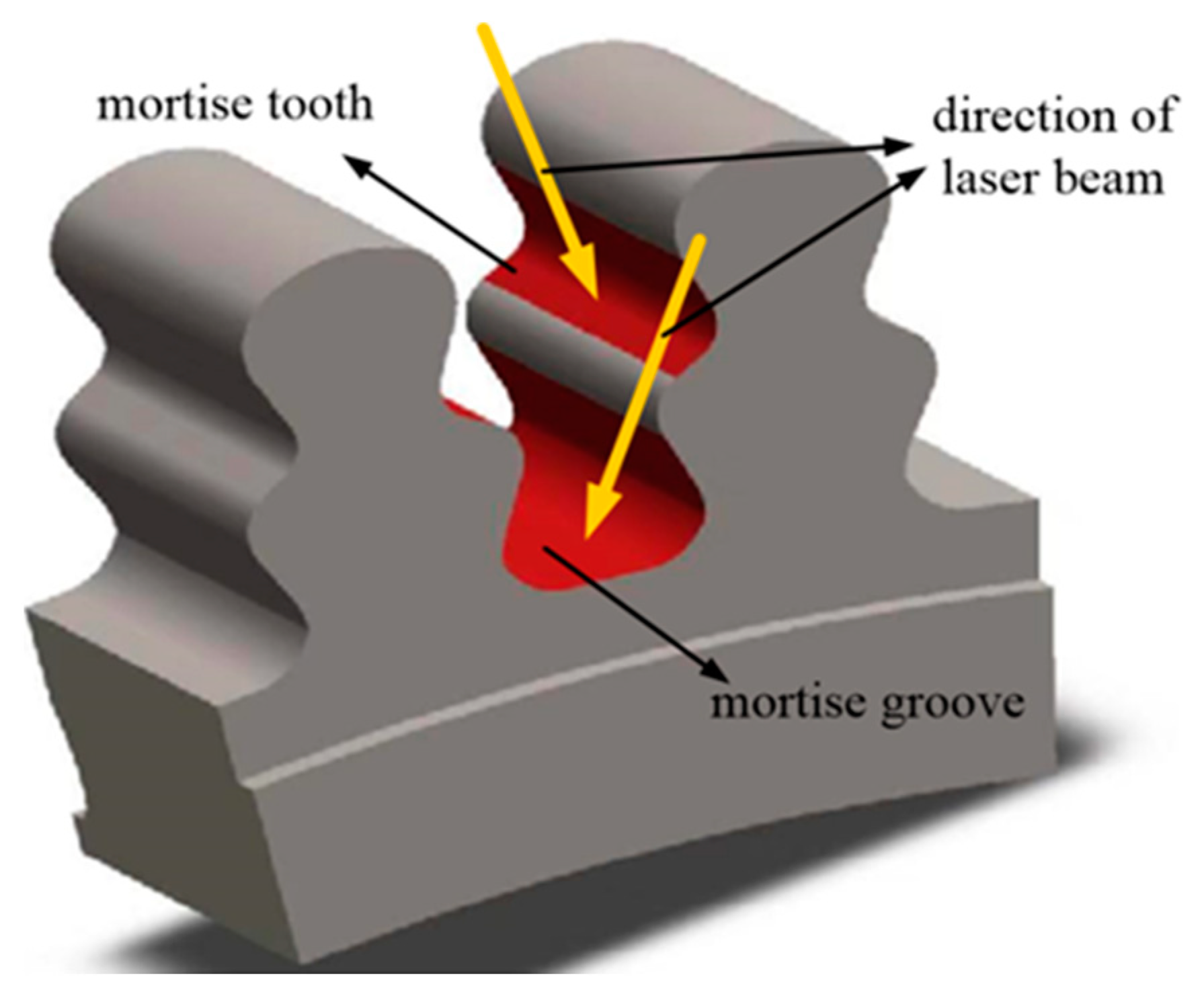
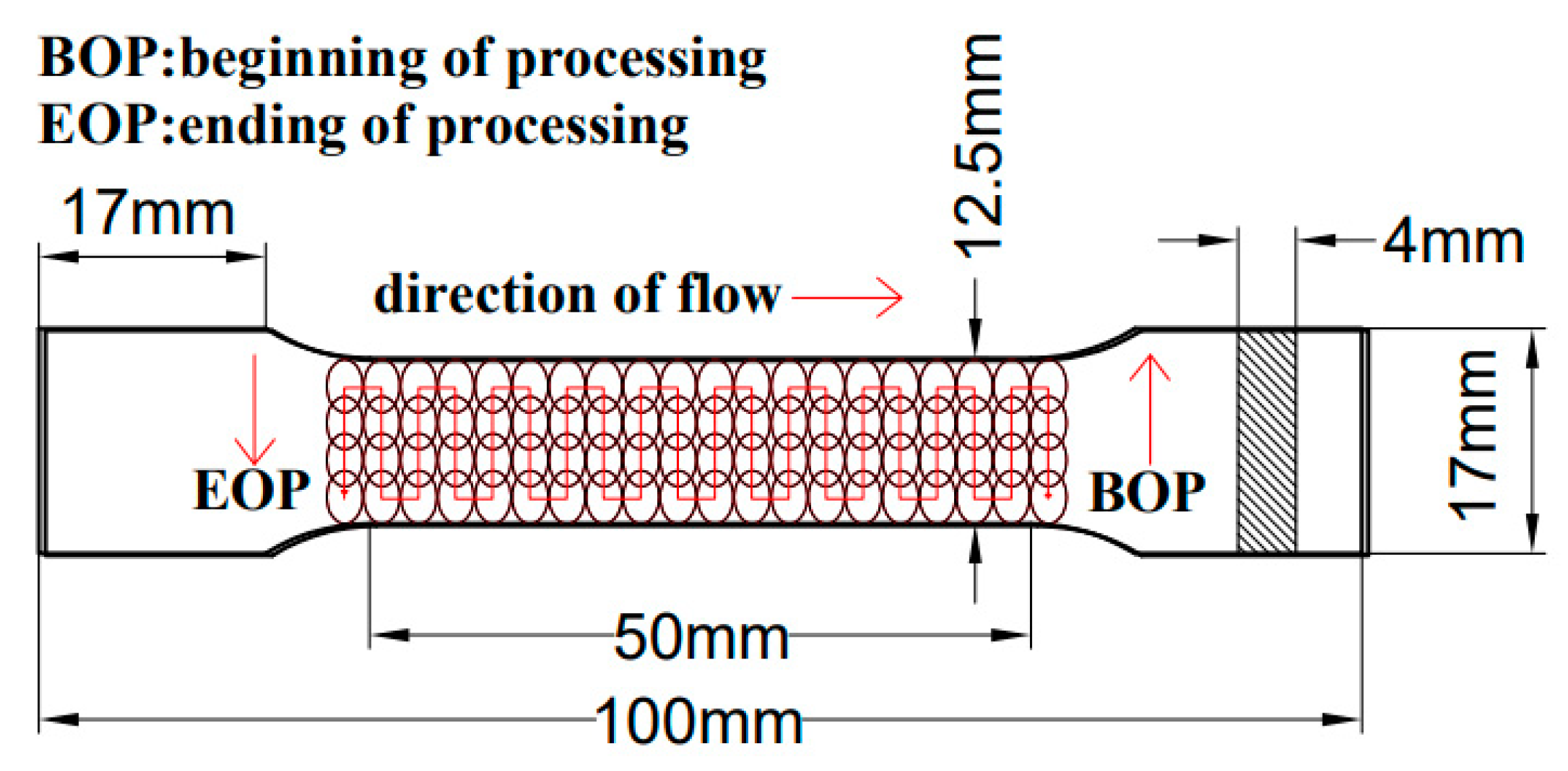

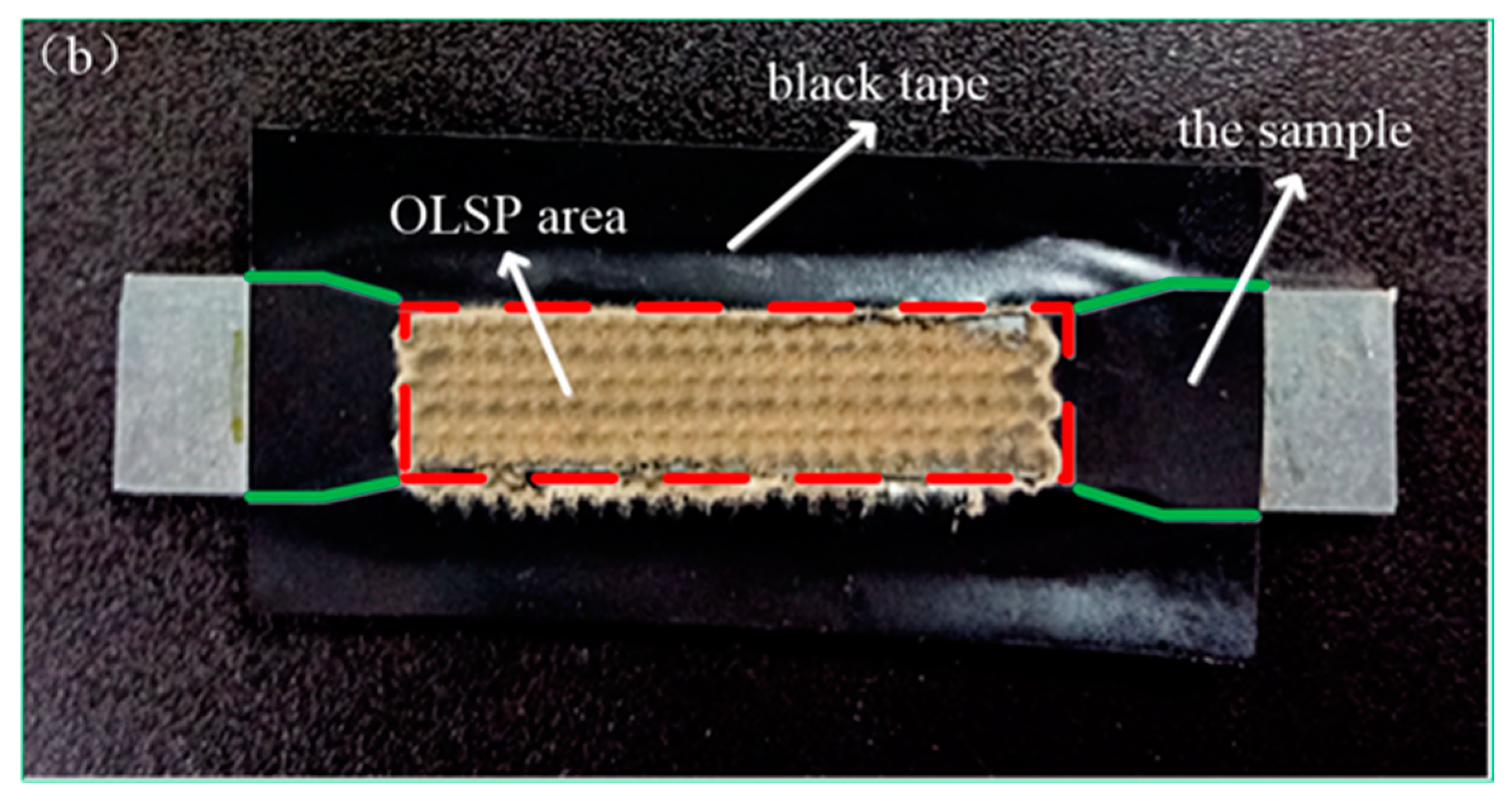
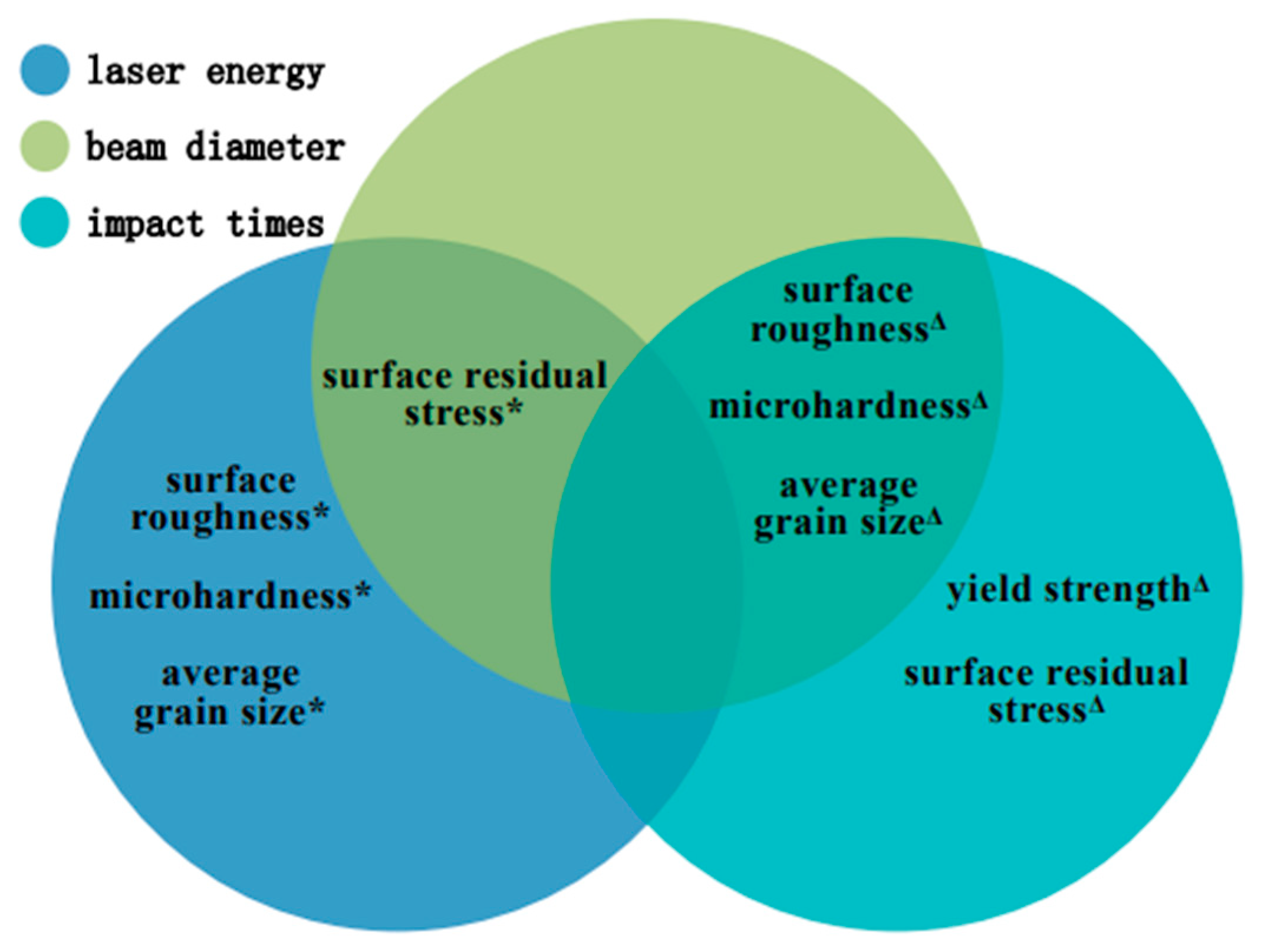
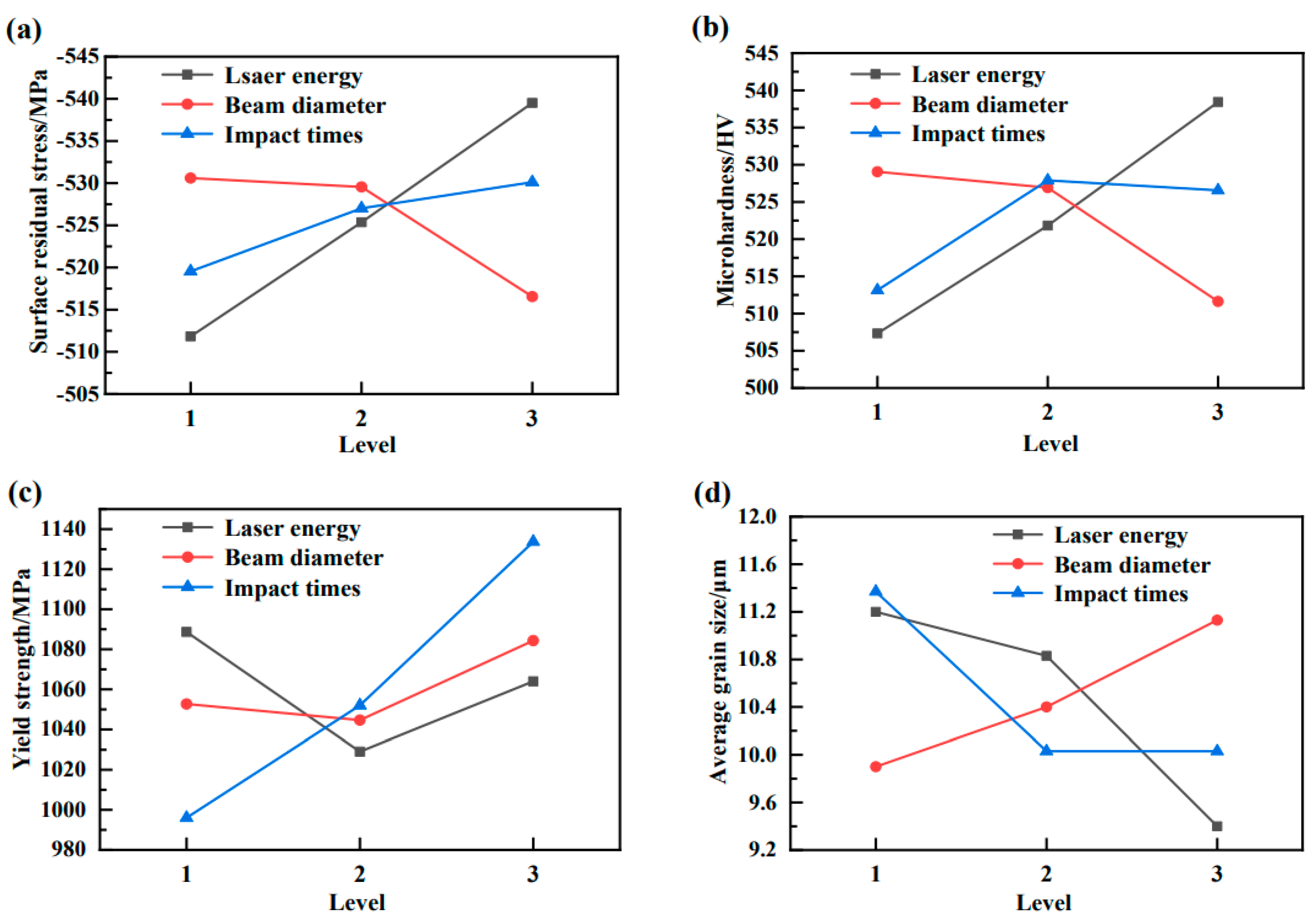


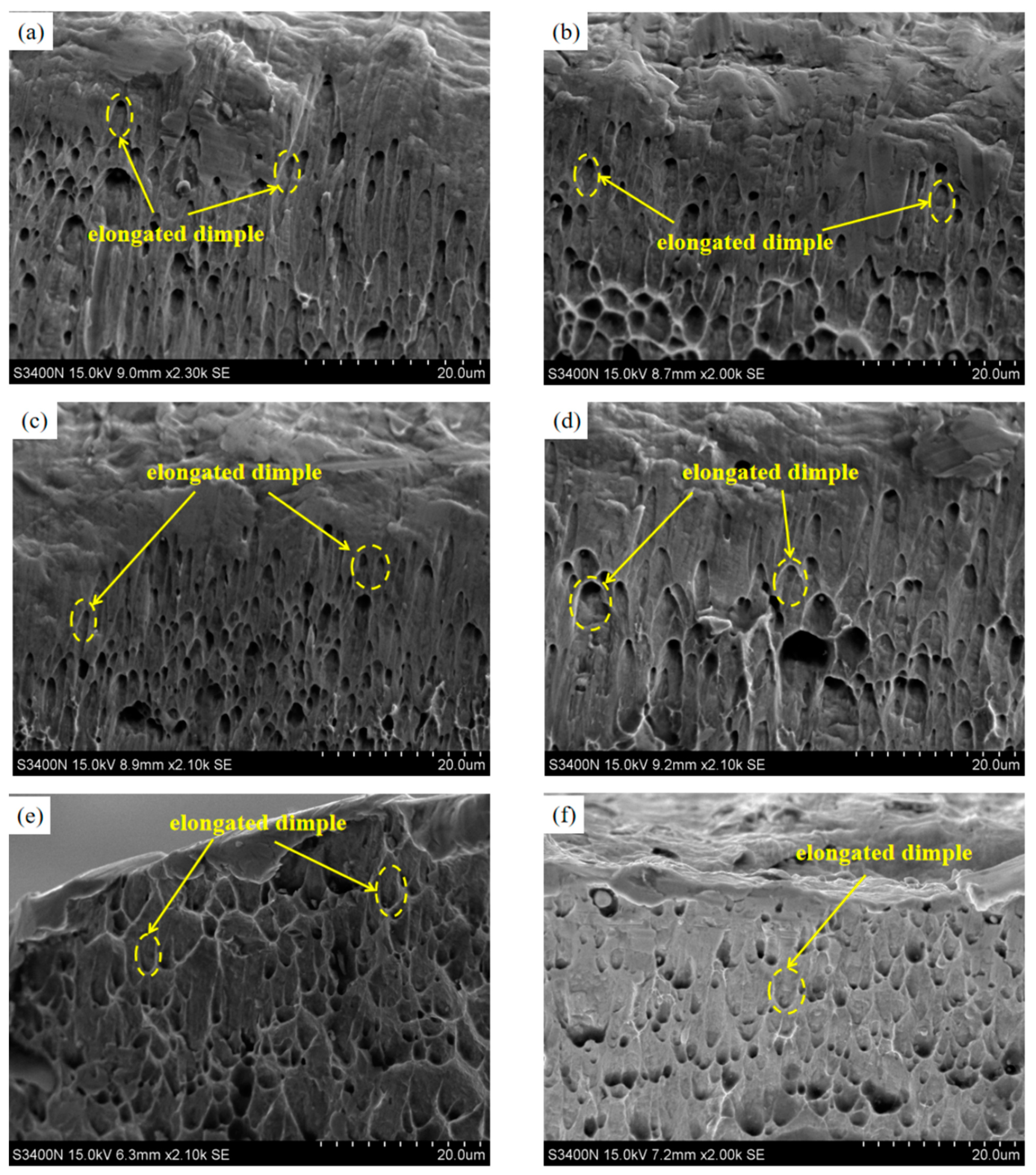

| Element | Mass Fraction/% | Element | Mass Fraction/% |
|---|---|---|---|
| Al | 3.400~3.500 | Mn | <0.100 |
| W | 3.350~3.450 | Zr | 0.040~0.070 |
| Nb | 3.300~3.500 | Ta | <0.050 |
| Mo | 3.300~3.480 | Si | 0.050~0.110 |
| Ti | 2.500~2.550 | P | <0.110 |
| Cr | 12.850~13.070 | S | 0.002~0.003 |
| Fe | 0.100~0.370 | C | 0.045~0.067 |
| Co | 7.950~8.020 | O | <0.005 |
| B | 0.011~0.014 | Ni | Margin |
| Level/Factor | Laser Energy/J | Beam Diameter/mm | Number of Impacts/No. |
|---|---|---|---|
| 1 | 4 | 3 | 1 |
| 2 | 6 | 4 | 2 |
| 3 | 8 | 5 | 3 |
| Test Number/No. | Laser Energy/J | Beam Diameter/mm | Number of Impacts/No. |
|---|---|---|---|
| 1 | 4 | 3 | 1 |
| 2 | 4 | 4 | 2 |
| 3 | 4 | 5 | 3 |
| 4 | 6 | 3 | 2 |
| 5 | 6 | 4 | 3 |
| 6 | 6 | 5 | 1 |
| 7 | 8 | 3 | 3 |
| 8 | 8 | 4 | 1 |
| 9 | 8 | 5 | 2 |
| 10 | Control group (UnOLSP) | ||
| Test Number (No.) | Surface Residual Stress (MPa) | Surface Roughness (μm) | Micro Hardness (HV) | Tensile Strength (MPa) | Yield Strength (MPa) | Elongation (%) | Average Grain Size (μm) |
|---|---|---|---|---|---|---|---|
| 1 | −511.42 | 13.91 | 506.65 | 1677 | 1005 | 35.35 | 11.3 |
| 2 | −515.49 | 13.96 | 517.77 | 1694 | 1083 | 35.08 | 10.8 |
| 3 | −508.54 | 13.85 | 497.61 | 1675 | 1178 | 35.29 | 11.5 |
| 4 | −533.03 | 14.31 | 530.87 | 1706 | 1005 | 35.63 | 9.9 |
| 5 | −534.48 | 15.16 | 532.42 | 1714 | 1075 | 35.16 | 10.1 |
| 6 | −508.56 | 10.96 | 502.19 | 1705 | 1007 | 36.3 | 12.5 |
| 7 | −547.35 | 17.95 | 549.65 | 1816 | 1148 | 34.76 | 8.5 |
| 8 | −538.67 | 15.46 | 530.58 | 1745 | 976 | 36.41 | 10.3 |
| 9 | −532.52 | 15.64 | 535.05 | 1748 | 1068 | 35.38 | 9.4 |
| 10 | −465.97 | 9.94 | 441.26 | 1587 | 971 | 36.61 | 15 |
| Factor | Value of Analysis | Surface Residual Stress | Surface Roughness | Micro Hardness | Tensile Strength | Yield Strength | Elongation | Average Grain Size |
|---|---|---|---|---|---|---|---|---|
| Laser energy | Mean square | 575.42 | 7.21 | 725.75 | 6070.33 | 2696.78 | 0.16 | 2.71 |
| F value | 79.22 * | 25.25 * | 36.44 * | 7.88 | 3.36 | 0.80 | 26.85 * | |
| Beam diameter | Mean square | 183.98 | 2.91 | 271.50 | 432.33 | 1320.11 | 0.14 | 1.15 |
| F value | 25.33 * | 10.18 Δ | 13.63 Δ | 0.56 | 1.64 | 0.69 | 11.42 Δ | |
| Number of impacts | Mean square | 88.58 | 3.67 | 199.82 | 543.00 | 14,378.78 | 0.71 | 1.78 |
| F value | 12.20 Δ | 12.86 Δ | 10.03 Δ | 0.70 | 17.90 Δ | 3.60 | 17.58 Δ |
| Indicator | Factor | |||||||
|---|---|---|---|---|---|---|---|---|
| Surface residual stress /MPa | Laser energy | −1535.45 | −1576.07 | −1618.54 | −511.82 | −525.36 | −539.51 | 27.69 |
| Beam diameter | −1591.80 | −1588.64 | −1549.62 | −530.60 | −529.55 | −516.54 | 14.06 | |
| Number of impacts | −1558.65 | −1581.04 | −1590.37 | −519.55 | −527.01 | −530.12 | 10.57 | |
| Surface roughness /μm | Laser energy | 41.72 | 40.43 | 49.05 | 13.91 | 13.48 | 16.35 | 2.87 |
| Beam diameter | 46.17 | 44.58 | 40.45 | 15.39 | 14.86 | 13.48 | 1.91 | |
| Number of impacts | 40.33 | 43.91 | 46.96 | 13.44 | 14.64 | 15.65 | 2.21 | |
| Micro hardness /HV | Laser energy | 1522.03 | 1565.48 | 1615.28 | 507.34 | 521.83 | 538.43 | 31.09 |
| Beam diameter | 1587.17 | 1580.77 | 1534.85 | 529.06 | 526.92 | 511.62 | 17.44 | |
| Number of impacts | 1539.42 | 1583.69 | 1579.68 | 513.14 | 527.90 | 526.56 | 14.76 | |
| Yield strength /MPa | Laser energy | 3266.00 | 3087.00 | 3192.00 | 1088.67 | 1029.00 | 1064.00 | 59.67 |
| Beam diameter | 3158.00 | 3134.00 | 3253.00 | 1052.67 | 1044.67 | 1084.33 | 39.66 | |
| Number of impacts | 2988.00 | 3156.00 | 3401.00 | 996.00 | 1052.00 | 1133.67 | 137.67 | |
| Average grain size /μm | Laser energy | 33.60 | 32.50 | 28.20 | 11.20 | 10.83 | 9.40 | 1.80 |
| Beam diameter | 29.70 | 31.20 | 33.40 | 9.90 | 10.40 | 11.13 | 1.23 | |
| Number of impacts | 34.10 | 30.10 | 30.10 | 11.37 | 10.03 | 10.03 | 1.33 |
Publisher’s Note: MDPI stays neutral with regard to jurisdictional claims in published maps and institutional affiliations. |
© 2021 by the authors. Licensee MDPI, Basel, Switzerland. This article is an open access article distributed under the terms and conditions of the Creative Commons Attribution (CC BY) license (https://creativecommons.org/licenses/by/4.0/).
Share and Cite
Lin, C.; Yu, L.; Zeng, J.; Wu, H.; Guo, X.; Liu, J.; Zhang, Y. Experimental Study on FGH95 Superalloy Turbine Disk Joint Material by Oblique Laser Shock Processing. Metals 2021, 11, 1770. https://doi.org/10.3390/met11111770
Lin C, Yu L, Zeng J, Wu H, Guo X, Liu J, Zhang Y. Experimental Study on FGH95 Superalloy Turbine Disk Joint Material by Oblique Laser Shock Processing. Metals. 2021; 11(11):1770. https://doi.org/10.3390/met11111770
Chicago/Turabian StyleLin, Chaohui, Longwei Yu, Jingling Zeng, Hebin Wu, Xiaojun Guo, Jianxin Liu, and Yongkang Zhang. 2021. "Experimental Study on FGH95 Superalloy Turbine Disk Joint Material by Oblique Laser Shock Processing" Metals 11, no. 11: 1770. https://doi.org/10.3390/met11111770






